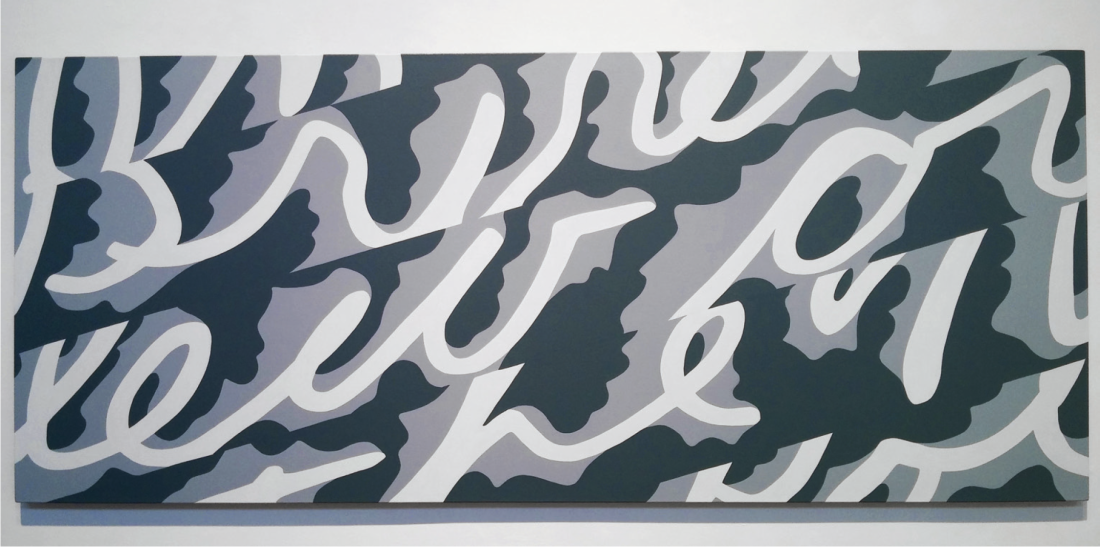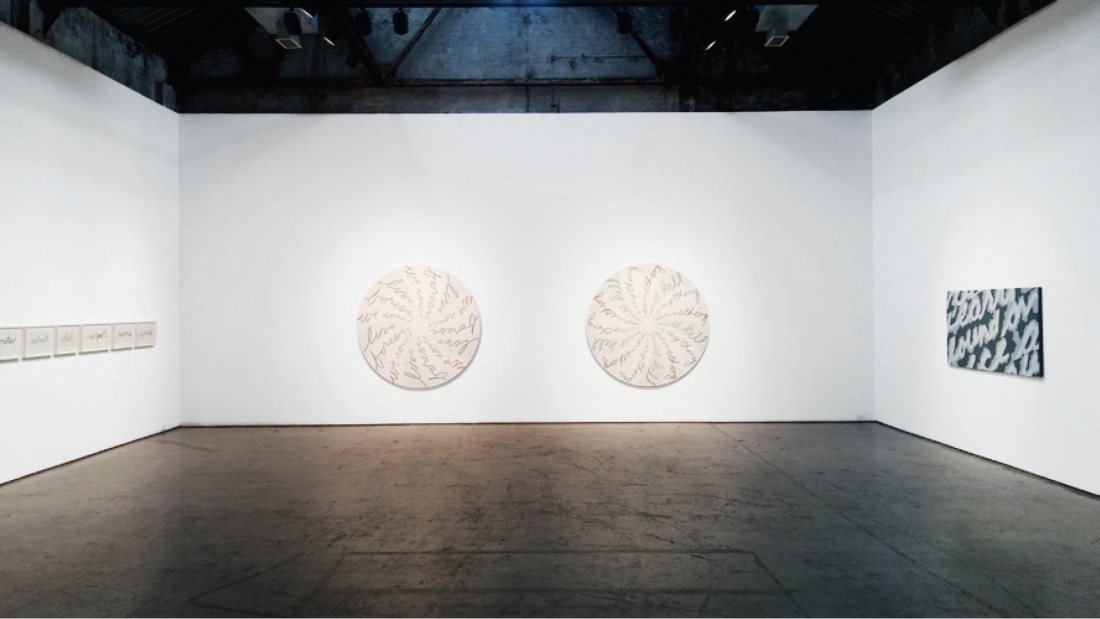Robert Fones
An opening statement from a chronically disorganized atheist: For years, I found Robert Fones’s art dichotomous, nigh impenetrable, staid/funky, obscurant/self- evident, decorous/decorative, puritan/frivolous, musty/modern, fusty/futurist, hermetic/philippic, above all and for all these reasons, intimidating. At the same time, I recognized and admired the intelligence, dedication, care, restraint and singularity with which he pursued his art; its purpose and logical conclusion, its austere elegance and beauty, its systematic exposition of language in all its myriad structures, variations, aberrations and issues (such as symbols); the ensuing analysis and breakdown of such, and the tessellated reconstruction of the bits into brittle object lessons. Certainly I am not alone in this conundrum. Much of the critical recognition that Fones has received qualifies as respect more than elucidation, often reliant on prima facie readings, closing his works in inevitable, irreducible, irrefutable literality, whereas I suspect that the art is actually generated from doubt and ambiguity. Of course, as a categorical atheist, I bring my own contradictory baggage to bear, particularly a recoil reflex at any indication of big- picture purpose on the horizon.
As this preamble makes clear, I am modifying my views. In Fones’s exhibition of new work, all from 2014, I detected a gentleness and sensitivity that had escaped me before, which I now retrospectively see, upon review of his past work, as a consistent attribute. At first encounter with these paintings, it is not clear what the images are. The titles do not necessarily help.

Robert Fones, Byrd Flew, 2014, oil on canvas, 33 x 79 inches. All images courtesy the artist and Olga Korper Gallery, Toronto.
Do you know what Apoptosis means? The term refers to the constant morphology of programmed cell death in organisms. It is essential to growth and survival, a process that eliminates cells that have outlived their purpose, approximately a shedding, repurposing and regeneration of the vital matter of which they are composed. In human beings, it occurs most dramatically in embryonic development, for instance a consumption of the webbing that initially binds fetal fingers and toes as they individuate. It also occurs 50 to 70 billion times a day in your body. Do Fones’s four acrylic paintings, Apoptosis 1 through 4, or the respective watercolour studies, illustrate or otherwise make more evident this concept? No, they do not. They do, however, succinctly illuminate the vast, ancient, eternal beauty and mystery of the idea, as it has been beheld by the artist. Ever the letterer/typographer/graphologist, Fones paints the gradated monochromes in graffiti fashion. From left to right, each successive, somewhat foliated form overlaps the subsequent one, a tribute to the manner of individual letters on a wall, a counter-intuitive convention that spells out the artistic act and style of the graffitist. The dermal leaves of each painting hew to a distinct morphological type. Some undulate, some scallop, some are lobed, some lap into points. The brushwork is immaculate, with no effort to disguise either the artifice or the craft of each applied stroke. The subtly creeping tonal adjustments of each sombre hue per segment, from saturation or shadow to dilution or light, are marvellously executed. The canvases themselves are appropriately web-like taut, sized over stretchers, so fastidiously folded over the edges and around the corners, the underlying carpentry seemingly transmits its precise integrity through the painted surface.
Do you know Areopagitica? Perhaps you do. (I didn’t.) It was John Milton’s polemical defense of freedom of speech published in 1644, replying to a parliamentary edict that all publication must be approved henceforth by the state. In 14 watercolours, Fones serially paints a very brief fragment, less than a sentence that goes like this: First / when / a city / shall / be as / it were / besieged / and / blocked / about / her /navigable / rivers [sic] / infested. Milton’s sentence (although not Fones’s paintings) continues thus: “…battle oft rumoured to be marching up even to her walls, and suburban trenches…,” an incendiary, articulate, imagistic portrayal of a crisis of the sort that today we are more likely to hear in a speech from The Hunger Games than the arena of public politics. Hung nearly adjacent in a row, each of these word paintings is copied after Fones’s cursive script, magnified several degrees, an exacting study of graphic strokes and the deposit of ink from the nib of the pen to the sheet of paper. For the most part, the paintings were produced in the sequence of the original phrase. Nine of the fourteen are dated, beginning with 3 Jan 2014 and continuing every few days to 29 Jan 2014. (The final four are undated.) Consequently, for all their consistency, variations are allowed in, primarily with respect to the background wash around the painted word. These rectangular fields are atmospheric, perhaps reflecting the quality of light of the day or a minute shift in mood or feeling by the painter.

Installation view, 2014, Olga Korper Gallery, Toronto. Photograph: Aaron Guravich.
Do you know Rob Fones’s grade 5 social studies notebook? Of course not. Herein is a clue to the subjectivity, privacy and introspection at the heart of Fones’s lifelong project. Words and passages from his 10-year-old’s notes in his 10-year-old’s hand, Fones similarly enlarges (even more so) and meticulously copies them out (recapitulating a standard school exercise), but he also stylizes and gives them a very different painterly treatment. After all, this is a self he no longer knows so well either. He slices his script off across its lower portions, corresponding with where the blue lines were printed on the foolscap pages, shedding the part below. Moreover, he collapses and presses the rows tightly upon one another and slants them up to the right, as a notebook may once have been positioned on its desk. The series “Polar Explorers” consists of Peary found, Admundsen was, Shackleton died, Scott hoped and Byrd flew. With considerable effort, difficulty and guesswork, phonetic bits may be discerned or deduced. There are no stories to be found any longer. Confronted with this foreign, un-analyzable writing, perhaps rapidly cycling through its own personal version of apoptosis even as it was being formed, Fones refers to his expertise in typography and graphic design. Each painting, again in the Modernist tradition of monochrome, is assigned a relative tonal value of background (dark), drift (intermediate) or lettering (light). Child and man, work and play, liberty and constraint, all oscillate back and forth, without resolution, without upper hand. ❚
Robert Fones was exhibited at Olga Korper Gallery, Toronto, from October 2 to October 28, 2014.
Ben Portis is a curator living in Toronto.

